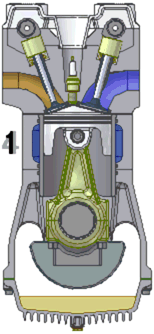Internal combustion engine
![]()
This article or section is still missing the following important information:
Unfortunately, nothing about the history of the internal combustion engine. Also very little about its use.
Help Wikipedia by researching and adding them.
An internal combustion engine, also referred to as an internal combustion engine in patent literature, is an internal combustion engine (also known as a heat engine) that converts chemical energy into mechanical work. For this purpose, an ignitable mixture of fuel and air (oxygen) is burned in a combustion chamber. The characteristic feature of all internal combustion engines is internal combustion, i.e. the generation of combustion heat in the engine. The thermal expansion of the resulting hot gas is used to set pistons (or rotors in the case of the Wankel engine) in motion. The most common types of internal combustion engines are gasoline (spark ignition) and diesel (compression ignition) engines. A typical application of these engines is to power motor vehicles (motor vehicles for short) such as automobiles or motorcycles, ships and aircraft. The abbreviation ICE (internal combustion engine) is used in the English language for internal combustion engines in vehicles.
The continuously operating jet and rocket engines as well as gas turbines are usually not counted as internal combustion engines, although the fuel is also burned inside the machine. Steam turbines, steam engines or the Stirling engine are not internal combustion engines, since the heat required for their operation is generated outside and not necessarily by combustion.

Four-stroke spark ignition engine as an example of an internal combustion engine. Naming of the power strokes: 1. Intake2 . Compression3 . Working4 . Exhausting
Basic operation
In all engines with internal combustion, the gas involved is changed after each working cycle, i.e. exhaust gas is expelled and fresh mixture (fresh gas) is supplied. The unused combustion heat that escapes with the exhaust gas is included in the power loss.
Modern engines compress the gas supplied to the working chamber, then combustion is initiated under pressure. The gas heats up strongly and the pressure increases. The engine relaxes the hot gas (for example with a retreating piston), the pressure and temperature of the gas fall and the volume increases. In the process, it performs mechanical work. Depending on the construction and function of the engine, these processes are carried out in different ways. Fundamental to its function as an engine is that, because of the combustion of the fuel-air mixture, the expansion of the mixture occurs at higher pressure than compression. The maximum efficiency possible depends on the temperature levels at which the heat of combustion is supplied and removed, and depends on the compression ratio and the cycle. Large two-stroke diesel engines achieve efficiencies of just over 50%. Modern automotive gasoline engines achieve an effective efficiency of 40 % at the best operating point (approximately in the middle of the speed band and just below the full load curve). For automotive diesel engines, it is 43 %. The efficiency is lower at high speeds and drops sharply as the load decreases because the mechanical losses in the engine hardly change over the load. They amount to about 10 % of the full load power and depend almost exclusively on the speed. (see consumption map). This is of particular importance for automotive engines in road traffic, as they are mainly operated in the lower partial load range. The average efficiency of a motor vehicle engine is therefore much lower than the maximum values. Crastan, for example, gives an average efficiency of 20 % for a conventional vehicle with a petrol engine.
Designations
In the first half of the 20th century, the Allgemeine Deutsche Sprachverein (General German Language Association) attempted to Germanize the compound foreign word Explosionsmotor (explosion engine). Explosion" became "Zerknall" (as still used today in "Kesselzerknall") and "engine" became "driver", among other things. Thus, the proposed German name for an internal combustion engine was "Zerknalltreibling" which has survived today only as a joking term.
Search within the encyclopedia